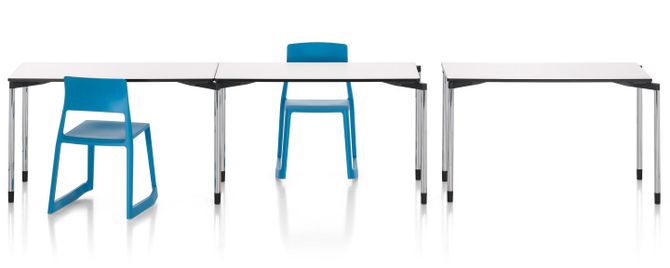
Map Table
Edward Barber & Jay Osgerby, 2011
Information
- Description: chipboard-faced blockboard panel. Central core made of solid wood strips (IF 20 glued according to DIN 68705) overlaid with chipboard.
- Fire performance: normal flammability, B2 B2 (DIN 4102-1), D-s2, d0 (EN 13501-1, CWFT).
- Environmental safety: meets (or exceeds) E1 category standards for environmentally safe emissions.
- Table top: melamine-coated.
- Description: laminated particle board with block core coated with melamine resin according to DIN EN 14322.
- Table thickness: thickness of finished table top approx. 19 mm.
- Edge: black ABS edge (3 mm).
- Safety: all edges and corners are rounded. Environmental safety: meets (or exceeds) E1 category standards for environmentally safe emissions.
- Note: threaded sleeves are screwed into the underside of the table top to facilitate the variable arrangement of the leg adaptors. Table tops are available in the colours soft light and dim grey.
Map Table
Map Table is a universal table system for situations requiring flexible configurations and optimal utilisation of space. Through their experience with the architectural design and development of training and conference venues, Edward Barber and Jay Osgerby came to recognise the need for a new, simple table system. Modern, communication-based methods of presentation and learning require adaptable table configurations. Team meetings and workshops are generally conducted at smaller clusters of tables, while open discussions are suited to circular groupings and conventional presentations call for layouts oriented to the speaker. The Map Table system is designed to satisfy these varying demands. The tables are quickly and easily rearranged and can be stacked if necessary. With its low-key functional aesthetic, Map Table is also well suited for use as a desk in home offices, which are rapidly gaining in importance in today's digital working world.
Edward Barber & Jay Osgerby
Edward Barber and Jay Osgerby studied architecture as fellow students at the Royal College of Art in London. Since that time, their collaborative work has probed the interface between industrial design, furniture design and architecture.